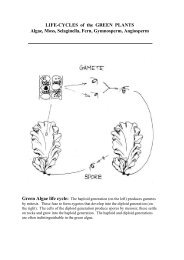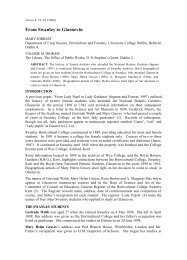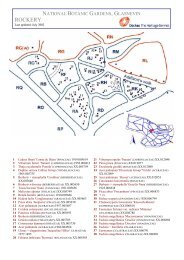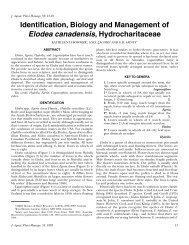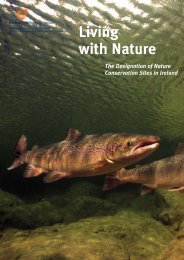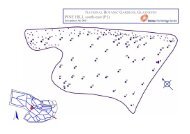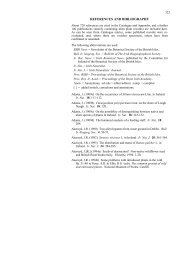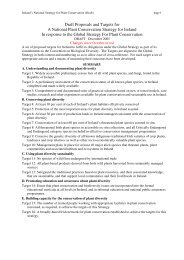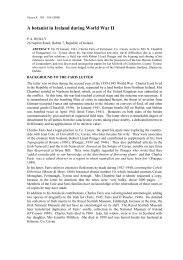THE PLANT KINGDOM - National Botanic Gardens
THE PLANT KINGDOM - National Botanic Gardens
THE PLANT KINGDOM - National Botanic Gardens
Create successful ePaper yourself
Turn your PDF publications into a flip-book with our unique Google optimized e-Paper software.
DIVISIONS (PHYLA) of the <strong>PLANT</strong> <strong>KINGDOM</strong>The divisions of the plant kingdom approximate to a pseudo-evolutionary sequence. That is theearlier divisions represent a life style that might be considered ‘primitive’, but we must rememberthat all living plants are equally ‘modern’. All the members exhibit a characteristic alternation ofgenerations, and have chlorophyl a & b (in approximately equal quantities), and carotenoids, andstore their food as starch.I-VII are sometimes called Cryptogams (hidden marriage), because they reproduceby spores. The male gametes are motile and are called sperm.I. HEPATICOPHYTA (Liverworts) 8,300II. ANTHOCEROTOPHYTA (Hornworts) 350III. BRYOPHYTA (Mosses) 13,500I-III have a very basic vascular system, which prevents them forming tall, branchingplants. In all 3 the haploid generation (gametophyte) is the conspicuous generation.In divisions IV-XII a vascular system is present, and these plants are sometimes calledTracheophytes (Vascular plants). The diploid generation (sporophyte) is conspicuous.IV. PSILOTOPHYTA (Whisk ferns) 3V. LYCOPHYTA (Club mosses) 850VI. SPHENOPHYTA (Horsetails) 25VII. PTEROPHYTA (Ferns) 8,600In divisions VIII-XII the gametophyte is not independent and is borne within the tissuesof the sporophyte. These plants reproduce by seeds, and are therefore sometimescalled Spermatophytes (Seed plants) or Phanerogams (visible marriage). In somebooks you will find all Gymnosperms in one Division (Pinophyta) with 4 sub-divisions(Cycadophytina, Pinophytina, Ginkgophytina and Gnetophytina).Divisions VIII-XI have seeds in a cone, but the ovule is not contained in an ovary, andare called Gymnosperms (Naked seeds).VIII.CYCADOPHYTA (Cycads) 160IX. PINOPHYTA (Conifers) 700X. GINKGOPHYTA (Ginkgo) 1XI. GNETOPHYTA (Gnetum, Ephedra, Welwitschia) 75The last division XII is the Angiosperms (Hidden seeds) in which the ovule is enclosedin a carpel, flowers are present and fruits.XII. MAGNOLIOPHYTA(Flowering plants)CLASS: Magnoliopsida (Dicots) 320,000CLASS: Liliopsida (Monocots) 80,000Hoplant 18 October, 2002
GYMNOSPERM differ from FERNS by:WOODLEAVESGAMETOPHYTESEEDSThey have Fibres, and develop Wood.(Fern trunks are erect rhizomes, roots and leaf bases).Ferns have branching leaves of indeterminate growthGymnosperms have simple or pinnate leaves.2 types: “Embryo sac” (Mega-sporangia)Pollen Grain (Micro-sporangia)Not independent of Sporophyte, being contained in “cones” onthe sporophyte. “Embryo sac” contained within an OvuleMale gametes motile in ferns, Cycads, and Ginkgo, but in otherGymnosperms nuclei in tubes. Not dependent on external water.Embryo contained within an endosperm, and surrounded bya seed coat.ANGIOSPERMS differ from GYMNOSPERMS by:WOODLEAVESFLOWERFRUITTracheids in Gymnosperms, Vessels in Angiosperms(rare in Winteraceae)Phloem Companion cellsHerbaceousnessEpicormic budsMore efficient water supply in Angios leads to Larger, broad leavesDeciduousnessUnique to Angiosperms. Bisexual‘Angiospermy’ (seeds hidden): Carpel & StigmaEconomy of Double fertilisationFlowering & Fruiting (Gymnosperm endosperms develop prior tofertilisation, in Angios flowering and fruiting occurs sequentially)Efficiency: Pollination & DispersalHoplant 18 October, 2002
GYMNOSPERMSGymnosperms are the most primitive of the ‘seed plants’. The Ovules are ‘naked’, which meansthey are exposed to the outside world through the narrow scale openings, and the pollen grain has toland on the micropylar opening of the integuments - there is no stigma. The micropyle exudes adrop of fluid - the pollination droplet - in most Gymnosperms.1. Gametophyte generation wholly enclosed by Sporophyte generation: does not existindependently.2. Female gametophyte (Megasporangia) is contained in an ‘Ovule’ in which the spore grows intothe embryo sac[=Megasporangia or Female gemetophyte]). Gametophyte develops into a largeendosperm (many thousands of haploid cells) prior to fertilisation. Each megasporangiadevelops several archegonia (2-5), if more than one is fertilised, then competition betweenembryos usually results in only one developing.3. Male gametophyte (Microsporangia) is enclosed in a Pollen grain (3 nuclei are present, one ofthese is the generative nucleus, and will form a motile ‘sperm’ or travel along a pollen tube)4. After fertilisation, the Embryo develops within an endosperm (haploid in Gymnosperms), and theinteguments develop into a hard seed coat.Gymnosperms are very varied, they do not have a single evolutionary origin, and four divisions areusually recognised:CYCADS (CYCADOPHYTA) Rarely-branched trunks with soft pithy wood. Dioecious(separate male and female plants).Leaves compound.Male gametes multi-cilliated, released from the male gametophyte after several months,sometimes after the seed has fallen.GINKGO (GINKGOPHYTA) Only 1 living species - Ginkgo biloba, probably native to China;widely cultivated in temperate areas. A "living fossil" with no close relatives (more diversein the Jurassic). Well branched, deciduous, dioecious (male & female) tree.Leaves alternate, simple, fan-shaped with dichotomous venation.Female gametophyte large, photosynthetic; male gametophyte producing 2 large swimmingsperm (multiflagellate) within the pollen tube.Embryo with 2 cotyledonsPINES, CYPRESSES, REDWOODS, YEWS etc. (PINOPHYTA: with 3 orders: Pinales,Cupressales, Taxales). Branched, woody trees, mostly monoecious. Resin canals in wood.Vascular system lacks vessels (Tracheids only).Pollination occurs 12 months prior to fertilisation. Pollen tube, and non-motile gamete.Embryo with 6 or more cotyledons.GNETUM, EPHEDRA, WELWITSCHIA (GNETOPHYTA: 3 orders: Ephedrales, Gnetales ,Welwitschiales) Plants of very diverse growth forms. All have vessels in the xylem, butthis has probably evolved independently of Angiosperms.Pollen tubes with non-motile gametes.Hoplant 18 October, 2002



